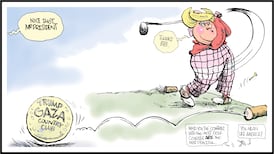In November 1884, the American Catholic Church held its third plenary council in Baltimore. The keynote speech was given by the Archbishop of Saint Paul, Dr John Ireland, one of the most remarkable Irishmen of his time, writes Fintan O'Toole.
Born in Co Kilkenny and forced to emigrate with his family during the Famine, he served as a chaplain in the union army on the front lines of the American civil war and, perhaps as a result, had a passionate commitment to republican democracy.
At the council, he chose to speak on "The Catholic Church and Civil Society".
What he said was, for conservative Catholics, quite appalling. He gave a ringing endorsement of the US constitution and in particular, its separation of church and state. The constitution, he argued, represented the "highest civil and political liberty".
The secular state which it established was not just a practical necessity but a positive good. By creating a neutral space between different religions, it protected religious freedom, not least that of the Catholic minority.
Ireland's doctrine was in stark contrast to the official Vatican line that there was but one true religion and that it should in principle be recognised as the official faith everywhere. But it opened the way to the eventual success of Irish Americans in politics, the law and the public education system by allowing them to be both good Catholics and loyal to the American Constitution.
I raise the apparently obscure example of Archbishop Ireland because his courageous and, at the time, extremely controversial stance speaks forcefully to current debates about multiculturalism in Ireland and Europe. The Catholic Irish are an outstanding example of a migrant group that succeeded both in integrating itself within its host society and in keeping its own sense of an ethnic identity.
For all the tensions and contradictions of their position, their experience is, in broad terms, what many of today's migrants would hope to repeat.
They became a forceful, self-confident and creative presence in their new society without having to give up their sense of difference. Isn't that what most well-disposed people would like to think the future will be for the Nigerians, Chinese, Romanians and so on who have come to Ireland and other parts of western Europe in recent years?
A huge factor in this success was secularism, especially in public education. One of the great figures of American life in the first half of the 20th century was the female Irish-American public school teacher. Irish women came to dominate this key sector of American culture and became, in the words of one historian, "America's first group of professional women". In doing well for themselves, they also gave an enormous gift to generations of Americans, so much so that their gradual disappearance is still mourned by those who see it is a key factor in the decline of public education.
This mutual advance was possible because, while the vast majority of these women were practising Catholics, the public school system was secular. It was a space where religion was neither a help nor a hindrance - a space, in other words, of religious freedom.
The ethic that dominated them, and that Archbishop Ireland had sanctioned, was that articulated by the US Supreme Court when it explicitly forbade public prayer in public schools in the late 1950s, the "belief that a union of government and religion tends to destroy government and to degrade religion".
All of this seems to me to be directly pertinent to the debate on the French government's proposals to ban religious display in public schools and, by implication, on the way we in Ireland should deal with the emergence of cultural pluralism.
It is interesting, for example that John Bruton's reply to a column I wrote on the subject last week is very similar in tone to the arguments for prayers in public schools in the US. He writes that "On the face of it, the way one student dresses for school does not harm other students".
This is exactly what the proponents of prayer in public schools in the US have always argued: the Buddhist or atheist kid can leave the room or just stay quiet and no harm is done.
This is a naïve argument. One look at any of the many Islamic websites that promote hijab (the covering of the female body) shows that, in the mind of those who believe in it, the decision not to cover-up is not neutral. It is a sign of immodesty, and therefore of not being worthy of respect.
In extreme versions, it is in fact an invitation to rape.
The Muslim woman who does not wear hijab, is, according to one site "nothing but a slave of your evil desire and behave worse than a kafir. By removing your hijab, you have destroyed your faith". Another warns that "Dresses that expose more than they conceal are an indirect temptation to the opposite sex for teasing, molestation and rape".
What was true for Irish Catholics in the US in the 19th century is true for Muslims in western Europe in the 21st: the neutral space of public education and public life is the best guarantor of personal and religious freedom.








